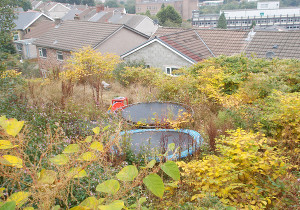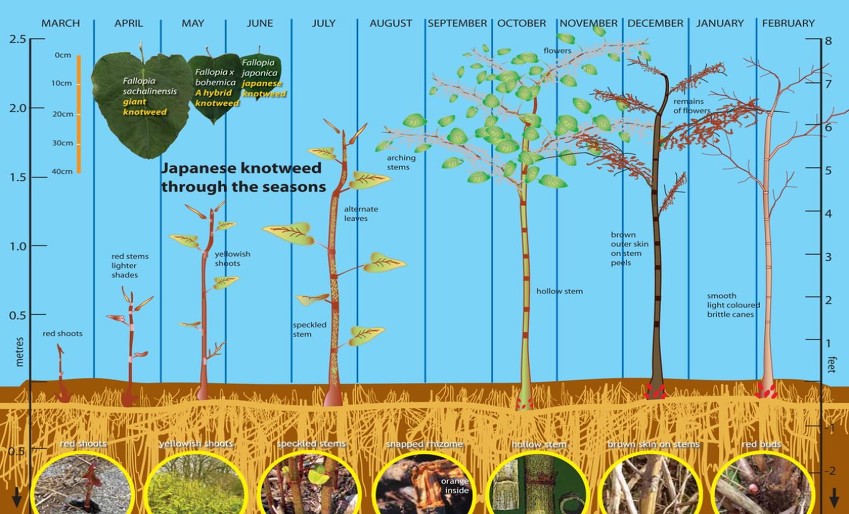What is Japanese knotweed?
Japanese Knotweed Identification Guide | Expert Identification Tips
How to Identify Japanese Knotweed: A Comprehensive Guide
Accurate Japanese knotweed identification is essential for property owners across Wales. This invasive plant can significantly impact property values and transactions, making early identification crucial. At Japanese Knotweed Elimination Ltd, our PCA-certified specialists have created this comprehensive guide to help you identify Japanese knotweed throughout its growth cycle. If you suspect Japanese knotweed on your property, this guide will help you recognise the key features before arranging a professional assessment.
Japanese Knotweed Identification: Seasonal Characteristics
Japanese knotweed (Fallopia japonica) changes dramatically throughout the year, making identification challenging for those unfamiliar with its seasonal variations. Our seasonal identification guide helps you recognize Japanese knotweed at any time of year.
Spring Japanese Knotweed Identification (March-May)
Spring is when Japanese knotweed begins its most vigorous growth phase, with distinctive features that make identification possible even in early stages.
Key Spring Identification Features:
The first signs of Japanese knotweed in spring include:
• Red/purple shoots: Distinctive asparagus-like spears emerge from the ground with a reddish-purple coloration
• Rapid growth rate: Shoots can grow up to 10cm per day in ideal conditions
• Unfurling leaves: Young leaves begin tightly rolled with a red vein pattern
• Emerging pattern: New shoots often appear in a cluster or line where rhizomes are present
• Early stems: Young stems begin to form with a distinctive purple speckled pattern
• Hollow structure: Even young stems develop a hollow interior similar to bamboo
During spring, Japanese knotweed can be confused with rhubarb due to the red coloration and emerging leaf pattern. However, Japanese knotweed shoots are more slender, grow more rapidly, and quickly develop into a bamboo-like stem structure that rhubarb lacks.
Summer Japanese Knotweed Identification (June-August)
Summer is when Japanese knotweed reaches its full growth potential, displaying its most recognizable characteristics.
Key Summer Identification Features:
Mature Japanese knotweed in summer displays:
• Impressive height: Plants typically reach 2-3 metres (6-10 feet) tall
• Bamboo-like stems: Distinctive canes with nodes and a hollow interior
• Zigzag growth pattern: Leaves alternate along the stem in a zigzag pattern
• Large leaves: Heart or shield-shaped green leaves reaching 10-15cm in length
• Dense foliage: Creates a thick canopy that often shades out other plants
• Cream/white flowers: Small clusters of flowers appear in late summer (August)
• Red-spotted stems: Mature stems develop distinctive red/purple speckles
• Thick growth: Forms dense stands where little else grows
Summer is when Japanese knotweed is most commonly identified, as its full growth makes it highly visible and distinctive. The combination of height, bamboo-like stems, and large shield-shaped leaves in a zigzag pattern is particularly characteristic.
Autumn Japanese Knotweed Identification (September-November)
Autumn brings distinctive changes to Japanese knotweed that provide additional identification features.
Key Autumn Identification Features:
In autumn, look for:
• Flowering: Clusters of small cream or white flowers on upright spikes
• Leaf discoloration: Leaves begin turning yellow as the plant prepares for dormancy
• Seed formation: Small winged seeds form (though rarely viable in the UK)
• Persistent height: Plants maintain their tall stature until the first frosts
• Dying stems: Stems begin changing from green to brown but remain standing
• Leaf drop: Leaves fall as winter approaches, leaving bare stems
Autumn flowering is a particularly useful identification feature, as the small cream-white flower clusters are distinctive and appear when many other plants have finished flowering.
Winter Japanese Knotweed Identification (December-February)
Even in its dormant winter state, Japanese knotweed remains identifiable through several key characteristics.
Key Winter Identification Features:
During winter dormancy, look for:
• Dead canes: Distinctive brown/orange dead stems remain standing
• Hollow stems: Dead canes are hollow with nodes similar to bamboo
• Brittle texture: Winter stems become brittle and easily snap
• No leaves: All foliage dies back completely
• Persistent stems: Unlike many plants, dead stems often remain upright throughout winter
• New buds: Toward late winter, new buds may form at ground level
Winter identification is particularly important for property surveys and land development, as the dormant rhizome network remains active below ground even when no visible growth appears above the surface.
If you suspect you have Japanese knotweed on your property, it’s essential to consult with a PCA-accredited specialist like Japanese Knotweed Elimination Ltd to assess the risk and begin professional treatment.
Japanese Knotweed Identification: Key Plant Features
Beyond seasonal variations, certain structural features help definitively identify Japanese knotweed throughout the year.
Stem Identification
Japanese knotweed stems have distinctive characteristics:
• Structure: Hollow, bamboo-like stems with clearly defined nodes
• Colour: Green with purple/red speckles, turning brown in winter
• Growth pattern: Stems grow straight upward with limited branching
• Height: Mature stems typically reach 2-3 metres (6-10 feet)
• Diameter: Usually 2-4cm in diameter when mature
• Interior: Distinctly hollow with partitions at the nodes
• Texture: Smooth exterior with no hairs or thorns
Leaf Identification
Japanese knotweed leaves are highly distinctive:
• Shape: Heart or shield-shaped (truncated base) with a pointed tip
• Size: Typically 10-15cm long and 7-12cm wide
• Arrangement: Alternate along the stem in a zigzag pattern
• Colour: Bright green in summer, yellowing in autumn
• Texture: Smooth with no hairs
• Veins: Distinct veining pattern with main veins coming from the base
• Edges: Smooth leaf margins without serrations
Flower Identification
Japanese knotweed flowers provide additional identification features:
• Colour: Creamy white to greenish-white
• Size: Small individual flowers approximately 0.5cm across
• Arrangement: Clustered in upright spikes (panicles) 10-15cm long
• Timing: Typically appear in late summer (August-September)
• Structure: Small with five petals or sepals
• Pollination: Attractive to bees and other pollinators
Rhizome Identification
The underground rhizome system is a critical identification feature, particularly for confirming Japanese knotweed during excavation:
• Colour: Orange/yellow interior when cut
• Texture: Woody with a cork-like outer layer
• Structure: Knotty appearance with nodes along the length
• Growth pattern: Extensive horizontal spread up to 7 metres from parent plant
• Depth: Typically grows up to 3 metres deep
• Regeneration: Capable of regenerating from fragments as small as 0.7 grams
• Persistence: Remains viable for up to 20 years in the soil
Plants Commonly Confused with Japanese Knotweed
Several plants are frequently mistaken for Japanese knotweed. Understanding the differences helps prevent misidentification.
Russian Vine (Fallopia baldschuanica)
Also known as “mile-a-minute” vine, Russian vine is related to Japanese knotweed but has important differences:
• Growth habit: Climbing vine rather than upright stems
• Leaves: Smaller, more elongated leaves
• Flowers: Similar white flower clusters but more abundant
• Stems: Thinner, twining stems without the bamboo-like structure
Bindweed (Calystegia sepium)
Bindweed is commonly confused with Japanese knotweed due to its similar leaf shape:
• Growth habit: Climbing or trailing vine rather than upright stems
• Leaves: Heart-shaped but typically smaller than knotweed
• Flowers: Large, trumpet-shaped white or pink flowers
• Stems: Thin, twining stems that wrap around other plants
Himalayan Balsam (Impatiens glandulifera)
Another invasive species often found in similar habitats:
• Stems: Pink-red, translucent and succulent rather than woody
• Leaves: Arranged in whorls or opposite pairs, not alternate
• Flowers: Large pink-purple flowers with a distinctive shape
• Height: Similar height to knotweed but with different structure
Broadleaved Dock (Rumex obtusifolius)
Young dock leaves can resemble emerging knotweed:
• Growth habit: Forms a rosette of leaves close to the ground
• Stems: Single central stem rather than multiple canes
• Leaves: Similar shape but with curled edges and less pointed tip
• Height: Much shorter than mature knotweed
Bamboo (Various species)
Perhaps the most common misidentification:
• Stems: Similar hollow, jointed stems but typically more woody
• Leaves: Long, narrow leaves unlike knotweed’s broad leaves
• Growth pattern: Stems branch more readily than knotweed
• Rhizomes: Different structure and growth pattern underground
Professional Japanese Knotweed Identification Services
While this guide provides comprehensive information for preliminary identification, professional confirmation is essential, particularly for property transactions or legal matters.
Why Professional Identification Matters
Professional Japanese knotweed identification provides:
• Certainty: Definitive confirmation of Japanese knotweed presence
• Documentation: Official reports for mortgage lenders and property transactions
• Risk assessment: Evaluation of potential structural impacts
• Treatment planning: Expert recommendations for effective control
• Legal protection: Evidence for property disclosures and neighbour disputes
• Peace of mind: Confirmation from certified specialists
Our Japanese Knotweed Identification Process
At Japanese Knotweed Elimination Ltd, our identification service includes:
1. Initial consultation: Discussion of your concerns and location details
2. Site visit: Thorough inspection by a PCA-certified surveyor
3. Sample analysis: Examination of plant material if identification is uncertain
4. Documentation: Comprehensive report with photographic evidence
5. Treatment recommendations: If Japanese knotweed is confirmed
6. Free quotation: For appropriate treatment programs
Free Japanese Knotweed Identification from Photographs
For preliminary identification, we offer a free photo assessment service:
1. Take clear photographs of the suspected plant, including:
– Full plant showing height and growth pattern
– Close-up of leaves showing shape and arrangement
– Stem details showing any distinctive coloration or nodes
– Flowers if present
2. Email your photos to info@knotweed-wales.com with your location details
3. Our specialists will provide an initial assessment based on your photographs
4. If Japanese knotweed is suspected, we’ll recommend a professional site survey
Japanese Knotweed Identification FAQs
How tall does Japanese knotweed grow?
Japanese knotweed typically reaches 2-3 metres (6-10 feet) in height during the summer growing season. In ideal conditions, it can occasionally grow taller, but this is the standard mature height in Wales.
Can Japanese knotweed be identified in winter?
Yes, Japanese knotweed can be identified in winter by its distinctive dead canes that remain standing. These canes are hollow, bamboo-like, and have a characteristic zigzag pattern where leaves were attached. However, professional confirmation is recommended during dormancy periods.
How quickly does Japanese knotweed grow?
During peak growing season in spring and early summer, Japanese knotweed can grow up to 10cm per day. A mature stand can reach its full height of 2-3 metres within just 4-6 weeks from initial emergence.
Can Japanese knotweed grow through concrete?
Japanese knotweed cannot directly penetrate solid concrete. However, it can exploit existing cracks, joints, or weaknesses in concrete structures, causing them to widen and creating the appearance of growing through concrete. The plant’s rhizomes exert significant pressure that can damage poorly constructed foundations, patios, and walls.
How far do Japanese knotweed roots spread?
Japanese knotweed rhizomes (underground stems) can spread up to 7 metres horizontally from the visible plants and penetrate up to 3 metres deep. This extensive underground network makes complete eradication challenging without professional treatment.

Flexible Payment Options Available
We offer 0% APR Monthly Payments or
You can split the cost over a number of years*

